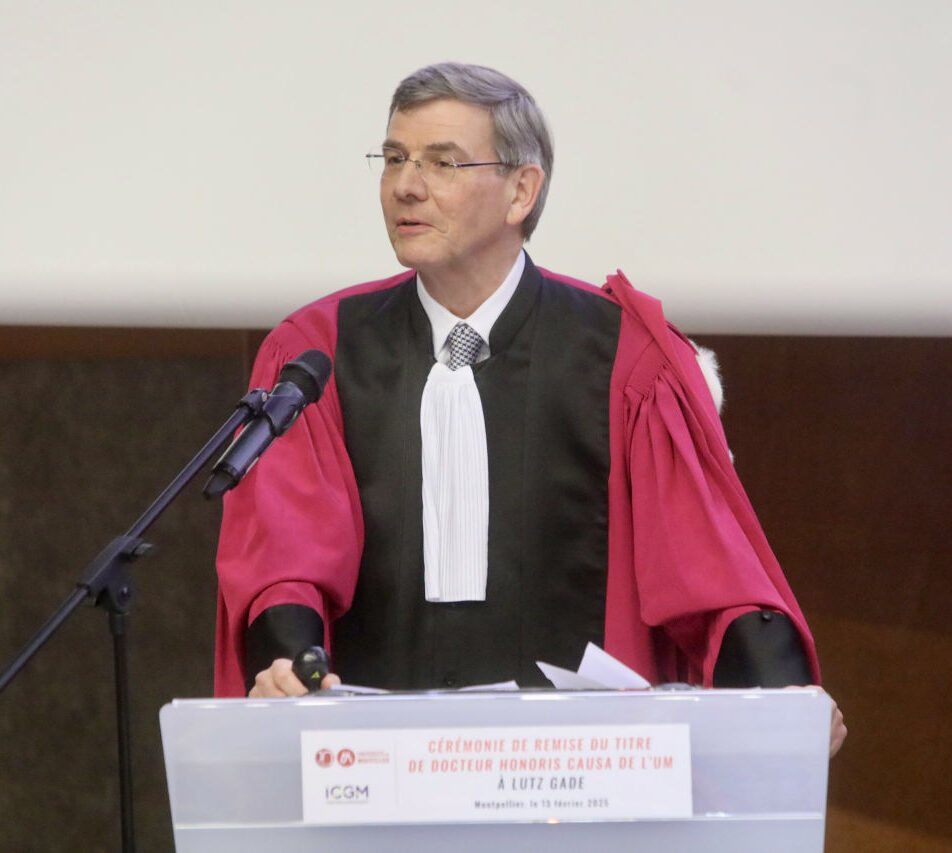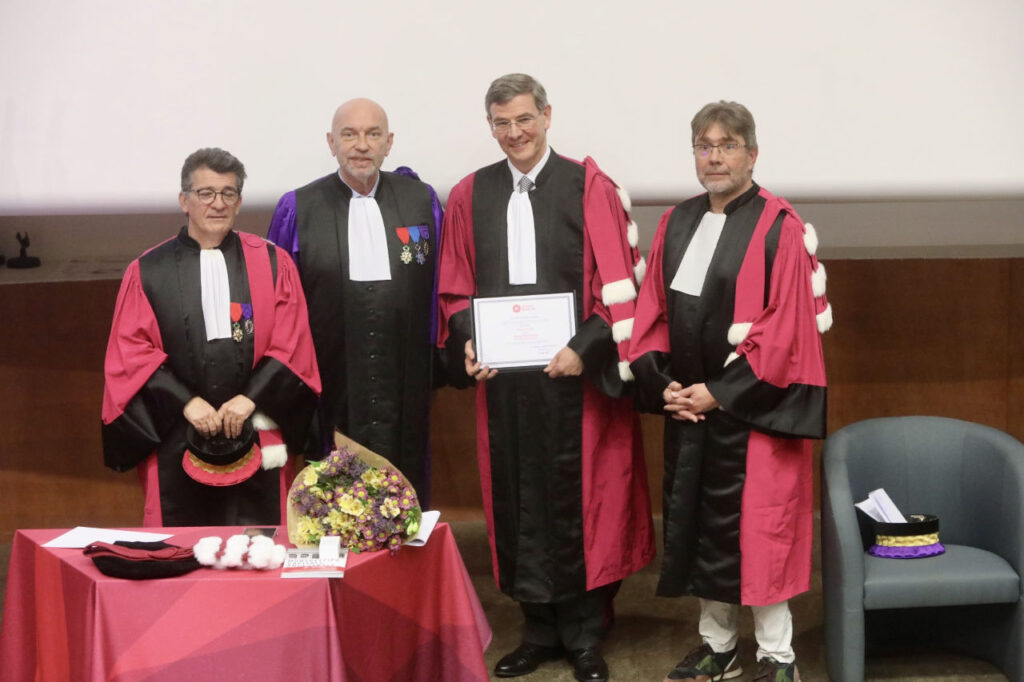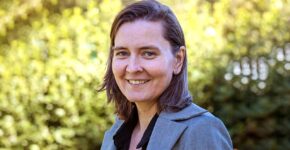Lutz Gade, the aesthete of chemistry
As Professor of Inorganic Chemistry at the University of Heidelberg and Director of the Institute of Inorganic Chemistry, Lutz Gade has built up world-renowned expertise in his field over the years. Over and above his academic achievements, it is also in recognition of his investment in cooperation between the University of Heidelberg and the University of Montpellier that he was awarded the honorary title of Doctor honoris causa by the UM in February 2025.

The few notes of music played as an introduction set the tone. An aria by Johann Sebastian Bach, delicate and harmonious, as the great German composer knows so well how to do. Just the thing for the ceremony to award the honorary title of Doctor Honoris Causa from the University of Montpellier to Lutz Gade, an elegant researcher from the University of Heidelberg whose international reputation is beyond question. With almost 350 publications and more than 60 supervised theses to his credit, this member of the prestigious Institut Universitaire de France has already won numerous awards, including the Franco-German prize of the Société Chimique de France in 2017.

Science and aesthetics
His speciality? His godfather, Éric Clot, director of research at the CNRS and head of the Charles Gerhard Institute in Montpellier since 2021, explains that " Lutz Gade is an expert in organometallic transition metal chemistry, which consists in positioning organic molecules around a metal to modify its properties, and therefore its behavior ". A field in which the properties of "organic" and "inorganic" molecules mutually enrich each other, and in which he has made a major contribution to the development of strong interactions between theory and practice.
But by choosing to focus his presentation on "Symmetry: the guiding principle in chemistry ", Lutz Gade showed a lesser-known side of his personality. That of a cultivated researcher, an aesthete, happy to share his fascination for the structuring of molecules, both scientifically and aesthetically, with as many people as possible. Questioning what guides his work, he readily admits that " chemistry is a creative science. As a molecular chemist, it's the geometry of molecules, the arrangement of atoms in space, whose controlled construction has been the objective of my scientific work ". All in impeccable French.
A taste for travel
Lutz Gade fell into the international game as a child. Born in Bonn, he spent part of his childhood in South Africa. Returning to Germany as a teenager, he studied chemistry in Bonn and Munich. He soon set off for new geographical horizons, preparing his thesis from 1989 to 1991 at the prestigious Cambridge University in England, under the supervision of one of the leading lights in his field, Lord Jack Lewis. A taste for travel that never left him, he spoke several languages fluently: Afrikaner, English, Spanish, French... The brilliant German researcher soon developed his first ties with France, as after a few years at the University of Würzburg, where he obtained his habilitation and became a lecturer, he began teaching inorganic chemistry at the Université Louis Pasteur in Strasbourg in 1998. He soon took on a wide range of responsibilities, including heading the organometallic chemistry and catalysis laboratory.
And what about Montpellier? When Lutz Gade arrived at the University of Heidelberg in 2003, in addition to his research and teaching work, he took charge of cooperation with the University of Montpellier, a long-standing partner of the German institution (see box). Coincidentally, a few years earlier, he had signed joint papers with a young CNRS researcher in theoretical chemistry named Éric Clot. After three joint publications and several missed opportunities to put a face to a name, the two men finally met in 2005. Nothing happened, each was busy with his own research, and time was running out.
A tenacious ally
It wasn't until 2014 that the first collaborations became concrete. " Lutz wanted his students to come to Montpellier to be trained in computational chemistry," says Éric Clot. Friendships were forged, and affinities were born on both scientific and cultural levels, " an attraction to foreign cultures as well as gastronomy, including fine wines ". With the same determination to get things moving by developing scientific collaborations between two institutions with a long shared history. "Lutz Gade is not just a chemist, he's a personality with undeniable charisma and presence, who knows how to give himself the means to act politically. He's as warm-hearted as he is tenacious: he doesn't give up easily," admits Éric Clot.
Thanks to their joint efforts, the two universities are forging closer ties, and Pascal Dumy, Director of the Ecole Nationale Supérieure de Chimie (ENSCM), has been swept along in the process. As a result, a chemistry mini-symposium will be held in Montpellier in January 2024, and two chemistry theses are currently being prepared in collaboration between the two universities. And there's no shortage of projects. " I look forward to continuing to work with you on scientific projects. But we will also be guided by our curiosity and our thirst for knowledge," concludes the German researcher in his acceptance speech. In addition to his active role at the University of Heidelberg, Lutz Gade is a long-standing ally of the University of Montpellier. A friend for over twenty years.
Montpellier-Heidelberg: a long history
The University of Montpellier (UM) and the University of Heidelberg (UdeH), two of Europe's oldest universities, have enjoyed close ties for over fifty years. Highlights of this shared history include the first official agreements between representatives of the University of Heidelberg's medical section and the Montpellier medical student cooperation in 1956, and the signing of a friendship charter between students from Montpellier and Heidelberg universities in 1957. This dynamic led to the twinning of the two cities in 1961.
Franco-German cooperation quickly developed between law faculties, before extending to many other fields such as pharmacy, economics, mathematics, physics, chemistry... The result is a first-rate strategic partnership that encompasses all the facets of a rich and diversified collaboration: student exchanges (more than 195 exchanges since 2010), scientific exchanges and collaborations, co-supervision of theses, creation of joint programs...
